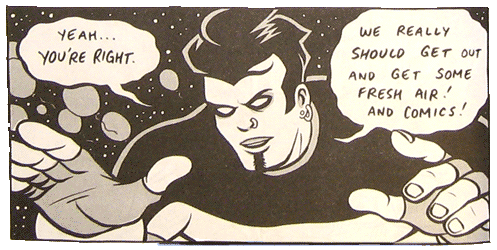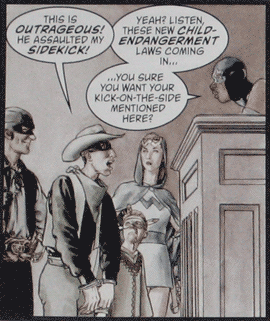

| May 2006 |
|
| Jay Stephens : Atomic City Tales | |
 I'm not quite sure if this is superhero parody, or straight superhero comedy, or postmodern post-superhero deconstruction. Felix, a young Hispanic-looking musician, meditating with a Tibetan drum, taps into the primevibe, the cosmic energy dating back to the Big Bang (which he takes as his nom de pouvoir). Instead of deciding on a specific power, Stephens simply gifts Felix with omnipotence. Whee!
I'm not quite sure if this is superhero parody, or straight superhero comedy, or postmodern post-superhero deconstruction. Felix, a young Hispanic-looking musician, meditating with a Tibetan drum, taps into the primevibe, the cosmic energy dating back to the Big Bang (which he takes as his nom de pouvoir). Instead of deciding on a specific power, Stephens simply gifts Felix with omnipotence. Whee!
Of course this creates some problems in plotting, because what the hell adventure can an omnipotent guy get into? So we soon find Bang encountering something called the Maniac Gang, whose standard old-guy leader, Doc Phantom, keeps taking away Bang's powers.
Bang doesn't exactly have allies, but he does have friends-- the cool-headed Adam, the Flaming Carrot imitation Quirk, and the cartoonist himself, Jay Stephens. (For awhile, he also dates the similarly near-omnipotent chick from the Maniac Gang, Z-Girl.) The best part about these early stories is Bang's young-stud arrogance. He's completely grooving on his new powers (and setting himself up for a fall); and Adam is reliably unimpressed. ("I'm not a sidekick, you numbskull! I'm a best friend!")
It's basically fluff, which plays with the genre conventions rather in the way of Beto Hernandez's BEM. There's a whole 24-page comic, for instance, that's largely about the Maniac Gang hanging around at home, bickering, and going shopping. Bang and Z-Girl hook up right in the middle of a fight, as Z discovers he's the kind of guy she's always wanted. And there's the amusing conceit that Stephens is actually Bang's friend, corralled into drawing up these adventures because Felix likes comics. I particularly liked the panel where Bang, after defeating some small bean-shaped villains, is shown eating them up like cereal.
The art is cartoony but good, and the use of gray screens gives the black-and-white panels a welcome depth. There's some neat effects with textures or suggestions of movement done in light gray.
The second TPB is entirely concerned with a big party Doc Phantom throws for the supervillain community-- he too is a big Jay Stephens fan, and kidnaps him to chronicle the proceedings. It's fun, but it hints that Stephens may have tired a bit of his hero, who comes off as more narcissistic than cool, and when he attempts to rescue his cartoonist gets severely pummelled for his pains.
| Alan Moore and Gene Ha : Top Ten | |

Top Ten is based on a simple idea: it's set in a city where everyone, from the mayor down to the bums on the street, has superpowers and aliases. People with heat vision, for instance, make good short-order cooks.
Not a bad idea; it could make a typically excruciating high-concept comedy movie; in fact I'm pretty sure it's been one. Moore, however, is incapable of simply tossing off a cheap joke; he creates glorious characters, clever dialog, complicated plots, and throws in some fairly heavy subjects. And still manages to tell the jokes.
The name refers to the Tenth Precinct of Neopolis; Moore's heroes are the city's cops. The central character is Robyn Slinger, alias Toybox, who's just joining the force. As she goes through her day, we meet a striking crew of characters-- her new partner Smax, invulnerable and a grade-A jerkazoid; Irma the nuclear-armed cracker; Sergeant Kemlo, part dog, part robot, part bad stand-up comic; Corbeau, the solid, sensible guy who gets his powers by listening to Satan. And they're soon up to their superpowered necks in murders, drug busts, and corruption.
If that wasn't enough, there's two books of variations. First is Smax, in which Robyn follows Smax to his homeworld for his uncle's funeral; it turns out to be a no-tech fantasy world which gives Moore and his artists (here Zander Cannon and Andrew Currie) license to make fun of a century's worth of fantasy and comics. And next is The Forty-Niners, about the previous generation of Tenth Precinct cops; it does a great job invoking the early postwar atmosphere... and it has Nazis and vampires as villains.
If Moore has a method, it may be that, in E.M. Forster's sense, he has no flat characters. There are so many characters that the focus never stays on one of them for long; and yet we learn more about them in each appearance than some writers could convey in a whole book. We first see the jokey surface, and their superpowers, and their amusing banter, or rarer moments when they reach out to help each other. We see the officers thrust into intense or violent situations they may or may not be able to handle. Then we see their family life, or their religion. In the end, like real people, they can't be reduced to just one attribute.
The art is outstanding throughout; and for once an American artist produces some beautiful futuristic cityscapes. For Forty-Niners, for the first time I have to single out a colorist's work: Art Lyon uses desaturated colors that suggest an old faded photograph, contributing greatly to the antiqued feel.
Another thing about Moore's books is that they're highly re-readable. The stories hold up; and better yet, once you're not quickly flipping pages to see how it ends, you can enjoy the piled-on in-jokes and shout-outs in the backgrounds.
